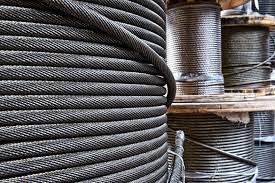Introduction
Cutting steel wire rope requires precision, the right tools, and a careful approach to ensure both effectiveness and safety. In this guide, we will provide a detailed walkthrough on how to cut steel wire ropes effectively, addressing common challenges and offering expert tips for a seamless process.
Choosing the Right Tools
Selecting the Appropriate Cutter
To achieve a clean and precise cut on steel wire rope, we recommend using a high-quality wire rope cutter. Opt for cutters specifically designed for steel wire, ensuring they are sharp and well-maintained for optimal performance. Investing in a quality cutter minimizes fraying and ensures a smooth cut.
Ensuring Safety with Personal Protective Equipment (PPE)
Before proceeding, prioritize safety by wearing the necessary Personal Protective Equipment (PPE). This includes gloves to protect your hands from sharp edges and safety glasses to shield your eyes from any debris.
Preparing the Steel Wire Rope
Measuring and Marking
Accurate measurements are crucial for a successful cut. Use a measuring tape to determine the desired length, and mark the spot where the cut will be made using a permanent marker. This ensures precision and minimizes the chance of errors.
Securing the Wire Rope
To prevent unnecessary movement during the cutting process, secure the steel wire ropes in a vice or clamp. This stabilizes the material, allowing for a controlled and accurate cut.
Executing the Cut
Applying Even Pressure
When using the wire rope cutter, apply even pressure throughout the cutting process. This prevents uneven cuts and reduces the risk of fraying or splintering. A controlled motion ensures a smooth and clean cut, meeting the desired specifications.
Lubricating the Cutter
For enhanced performance and durability of the cutting tool, consider applying a lubricant before each use. This reduces friction, allowing the cutter to move through the steel wire ropes effortlessly. Regular lubrication also prolongs the life of the tool.
Addressing Common Challenges
Fraying and Splintering
Fraying and splintering are common challenges when cutting steel wire rope. To mitigate these issues, make sure to use a sharp cutter and follow proper cutting techniques. Additionally, inspect the cutter regularly for any signs of wear and tear.
Rust Prevention
Steel wire rope is susceptible to rust, especially after cutting. To prevent corrosion, apply a rust inhibitor or a coating of anti-corrosive solution to the cut ends. This simple step extends the longevity of the steel wire rope.
Conclusion
Cutting steel wire rope demands precision, the right tools, and a commitment to safety. By following the steps outlined in this comprehensive guide, we ensure a seamless cutting process that meets your specifications while maintaining safety standards


